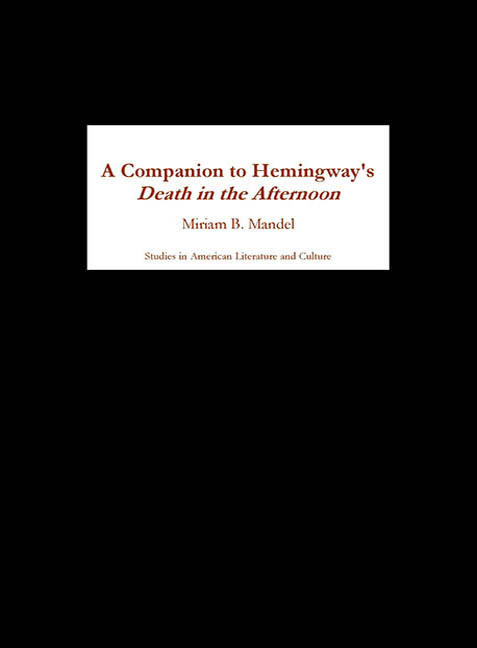Book contents
- Frontmatter
- Dedication
- Contents
- Acknowledgments
- Hemingway Works That Address the Bullfight
- A Note on the Text of Death in the Afternoon
- Introduction
- Composition, Sources, and Backgrounds
- Reading Texts, Paratexts, and Absence
- “The Real Thing–? Representing the Bullfight and Spain in Death in the Afternoon
- “Very Sad but Very Fine”: Death in the Afternoon 's Imagist Interpretation of the Bullfight-Text
- “Far from Simple”: The Published Photographs in Death in the Afternoon
- Deleted “Flashes”: The Unpublished Photographs of Death in the Afternoon
- “¿Qué tal, hombre, qué tal?”: How Paratexts Narrow the Gap between Reader and Text in Death in the Afternoon
- On Authorship and Art
- And What Came After
- Works Cited
- Notes on the Contributors
- Index
“The Real Thing–? Representing the Bullfight and Spain in Death in the Afternoon
from Reading Texts, Paratexts, and Absence
Published online by Cambridge University Press: 27 April 2017
- Frontmatter
- Dedication
- Contents
- Acknowledgments
- Hemingway Works That Address the Bullfight
- A Note on the Text of Death in the Afternoon
- Introduction
- Composition, Sources, and Backgrounds
- Reading Texts, Paratexts, and Absence
- “The Real Thing–? Representing the Bullfight and Spain in Death in the Afternoon
- “Very Sad but Very Fine”: Death in the Afternoon 's Imagist Interpretation of the Bullfight-Text
- “Far from Simple”: The Published Photographs in Death in the Afternoon
- Deleted “Flashes”: The Unpublished Photographs of Death in the Afternoon
- “¿Qué tal, hombre, qué tal?”: How Paratexts Narrow the Gap between Reader and Text in Death in the Afternoon
- On Authorship and Art
- And What Came After
- Works Cited
- Notes on the Contributors
- Index
Summary
The notion of authenticity, and the capturing of it by one means or another, was an important one to Hemingway throughout his artistic career. In Death in the Afternoon, he uses the phrase “the real thing” twice to describe, in turn, the two subjects, writing and bullfighting, which are linked in symbiotic connection throughout the book. The best known of these occasions is early in the text, when he makes one of his most famous pronouncements on what he was aiming to achieve in his own writing: “the real thing, the sequence of motion and fact which made the emotion and which would be as valid in a year or in ten years or, with luck and if you stated it purely enough, always” (DIA, 2). The second is when he is writing of the “ecstasy” produced by a “brilliant faena,” the series of muleta passes made by the matador in the final third of the bullfight. Describing the “emotional and spiritual intensity and pure, classic beauty that can be produced by a man, an animal and a piece of scarlet serge draped over a stick,” he then adds, “if you should ever see the real thing you would know it” (206–7). Throughout the book, this phrase is linked to words like “true,” “pure,” “honest,” “sincere,” “simple,” “integral,” and their derivatives.
But Hemingway does not give us “the real thing” when he describes bullfighting in Death in the Afternoon. Instead, we get his version of that reality. To view bullfighting in terms of ecstasy and emotional and spiritual intensity, and to see its climax in the death of the bull and the act of “killing beautifully” (252), “death uniting the two figures [man and bull] in the emotional, aesthetic and artistic climax of the fight” (247), is clearly to give a highly subjective version of what Hemingway sees not as a sport but as “a tragedy” (16) and a “sculptural art” (13). Most non-Spaniards, after all, present bullfighting from a quite different, and morally condemnatory, perspective. Hemingway in this respect is very much an exception to the norm, his view of bullfighting and its morality — “I know only that what is moral is what you feel good after” (4) — in strong contrast with the majority of foreign critics both before and after his time of writing.
- Type
- Chapter
- Information
- A Companion to Hemingway's Death in the Afternoon , pp. 123 - 142Publisher: Boydell & BrewerPrint publication year: 2004



